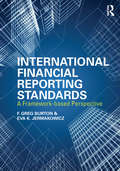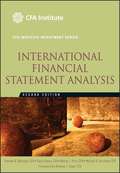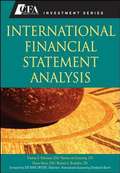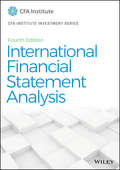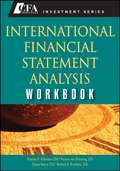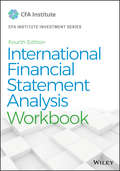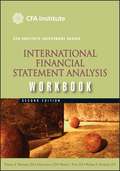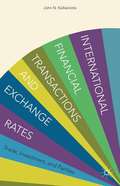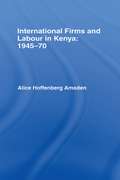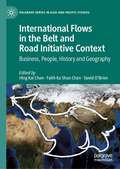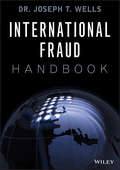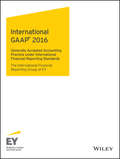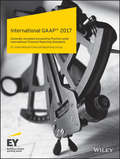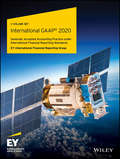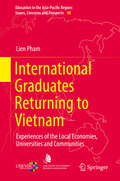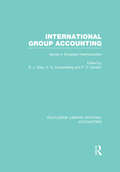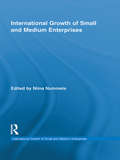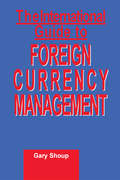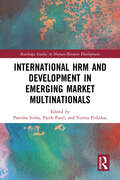- Table View
- List View
International Financial Reporting Standards: A Framework-Based Perspective
by Greg F. Burton Eva K. JermakowiczInternational Financial Reporting Standards: A Framework-based Perspective links broad concepts and general accounting principles to the specific requirements of IFRS to help students develop and understand the judgments required in using a principle-based standard. Although it is still unclear whether the US will adopt IFRS, the global business environment makes it necessary for accounting students and professionals to be bilingual in both US GAAP and IFRS. This comprehensive textbook offers: A clear presentation of the concepts underlying IFRS A conceptual framework to guide students in interpreting and applying IFRS rules A comparison between IFRS and US GAAP to develop students’ understanding of the requirements of each standard Real world examples and case studies to link accounting theory to practice, while also exposing students to different interpretations and applications of IFRS End of chapter material covering other aspects of financial reporting, including international auditing standards, international ethics standards, and corporate governance and enforcement, as well as emerging topics, such as integrated accounting, sustainability and social responsibility accounting and new forms of financial reporting Burton & Jermakowicz have crafted a thorough and extensive tool to give students a competitive edge in understanding, and applying IFRS. A companion website provides additional support for both students and instructors.
International Financial Statement Analysis
by Elaine Henry Thomas R. Robinson Michael A. Broihahn Anthony T. Cope Wendy L. PirieUp-to-date information on using financial statement analysis to successfully assess company performance, from the seasoned experts at the CFA InstituteDesigned to help investment professionals and students effectively evaluate financial statements in today's international and volatile markets, amid an uncertain global economic climate, International Financial Statement Analysis, Second Edition compiles unparalleled wisdom from the CFA in one comprehensive volume.Written by a distinguished team of authors and experienced contributors, the book provides complete coverage of the key financial field of statement analysis. Fully updated with new standards and methods for a post crisis world, this Second Edition covers the mechanics of the accounting process; the foundation for financial reporting; the differences and similarities in income statements, balance sheets, and cash flow statements around the world; examines the implications for securities valuation of any financial statement element or transaction, and shows how different financial statement analysis techniques can provide valuable clues into a company's operations and risk characteristics.Financial statement analysis allows for realistic valuations of investment, lending, or merger and acquisition opportunitiesEssential reading for financial analysts, investment analysts, portfolio managers, asset allocators, graduate students, and others interested in this important field of financeIncludes key coverage of income tax accounting and reporting, the difficulty of measuring the value of employee compensation, and the impact of foreign exchange rates on the financial statements of multinational corporationsFinancial statement analysis gives investment professionals important insights into the true financial condition of a company, and International Financial Statement Analysis, Second Edition puts the full knowledge of the CFA at your fingertips.
International Financial Statement Analysis
by Thomas R. Robinson Michael A. Broihahn CFA Hennie van Greuning CFA Sir David Tweedie Elaine Henry CfaWritten with both the established and aspiring financial professional in mind, this book will help you understand the mechanics of the accounting process, which is the foundation for financial reporting; comprehend the differences and similarities in income statements, balance sheets, and cash flow statements around the globe; and assess the implications for securities valuation of any financial statement element or transaction. Along the way, you'll also discover how different financial analysis techniques--such as ratio analysis and common-size financial statements--can provide valuable clues into a company's operations and risk characteristics.
International Financial Statement Analysis (CFA Institute Investment Series #119)
by Thomas RobinsonBetter analysis for more accurate international financial valuation International Financial Statement Analysis, 4th Edition provides the most up-to-date detail for the successful assessment of company performance and financial position regardless of country of origin. The seasoned experts at the CFA Institute offer readers a rich, clear reference, covering all aspects from financial reporting mechanics and standards to understanding income and balance sheets. Comprehensive guidance toward effective analysis techniques helps readers make real-world use of the knowledge presented, with this new third edition containing the most current standards and methods for the post-crisis world. Coverage includes the complete statement analysis process, plus information on income tax accounting, employee compensation, and the impact of foreign exchange rates on the statements of multinational corporations.
International Financial Statement Analysis Workbook (CFA Institute Investment Series #23)
by Elaine Henry Thomas R. Robinson Michael A. Broihahn Hennie van Greuning CFATo enhance your understanding of the tools and techniques presented in International Financial Statement Analysis, pick up the International Financial Statement Analysis Workbook. This companion study guide contains carefully constructed problems with detailed solutions as well as concise learning outcome statements and summary chapter overviews. With this Workbook, you can test your understanding of the many issues associated with this discipline, before putting them to use in real-world situations. If you intend on acquiring a practical mastery of international financial statement analysis, this informative guide can help you succeed.
International Financial Statement Analysis Workbook (CFA Institute Investment Series #23)
by Thomas R. RobinsonPractice the concepts, tools, and techniques of international financial statement analysisInternational Financial Statement Analysis Workbook gives busy professionals and those aspiring to a financial career a hands-on reference for understanding and applying the concepts and methodologies essential to accurate financial analysis. A companion to the International Financial Statement Analysis text, this practical workbook includes learning outcomes, chapter summaries, and problems that are designed to build skills and boost confidence before applying the concepts to real-world cases. The workbook offers an opportunity to test your understanding of the standards and mechanics of financial reporting and makes use of the text’s tools and techniques. This informative guide—which has practical application across international borders—aids in the understanding of financial reporting standards, income statements, balance sheets, cash flow statements, inventories, long-lived assets, income taxes, and much more. International Financial Statement Analysis Workbook is designed to facilitate information retention and build a strong foundation in financial statement analysis. It’s impossible to tell how well a subject is mastered without applying the relevant concepts to situations based in the real world. International Financial Statement Analysis Workbook offers the opportunity to: • Work topic-specific practice problems to facilitate intuitive understanding • Review each topic quickly using clear chapter summaries • Understand each chapter’s objective to avoid missing key information • Practice important methods and techniques before applying them in the real world International Financial Statement Analysis Workbook, Fourth Edition provides the most up-to-date knowledge and helps to apply that knowledge with carefully constructed problems.
International Financial Statement Analysis Workbook, 3rd Edition
by Elaine Henry Thomas R. Robinson Michael A. Broihahn Anthony T. Cope Wendy L. PirieThe workbook you need to test your understanding of financial statement analysis, from the seasoned experts at the CFA Institute In a global, highly interconnected investment landscape, financial analysts must have a thorough, working knowledge of international financial statement analysis. This companion Workbook to International Financial Statement Analysis, Second Edition accompanies the second edition of International Financial Statement Analysis, the essential guide to this important field, written by top experts at the CFA Institute. Designed to help busy professionals understand and apply the concepts and methodologies essential to accurate financial analysis, this workbook enables readers to test their knowledge and comprehension of the tools and techniques described in the main text before putting them to use in real world situations. This informative study guide contains carefully constructed problems with detailed solutions, as well as concise learning outcome statements and summary chapter overviews. The must-have companion to International Financial Statement Analysis, Second Edition Filled with pedagogical tools for applying key concepts Chapter overviews include coverage of: the differences and similarities in income statements, balance sheets, and cash flow statements around the world; the impact of foreign exchange rates on the financial statements of a multinational corporation; the difficulty in measuring the value of employee compensation; the importance of income tax accounting and reporting, and much more To acquire a practical mastery of international financial statement analysis, you need to be able to practice putting theory into action, and International Financial Statement Analysis Workbook, Second Edition provides the review resources you need to succeed.
International Financial Statistics
by International Monetary FundThis annual publication contains detailed statistics on all aspects of international and domestic finance, mostly covering the years 1993-2004. The first volume contains world and area tables with data covering topics including exchange rates, fund accounts, international reserves, balance of payments and commodity prices; as well as individual country data tables for most IMF members, selected other countries and economic groupings on topics including exchange rates, international liquidity, interest rates, international investment, balance of payments, and national accounts. The second volumes contains country notes with details of compilation techniques and data sources used.
International Financial Transactions And Exchange Rates
by John N. KallianiotisInternational transactions among nations and multinational corporations are important and growing due to the openness of economies all over the world. In this follow-up title to Exchange Rates and International Financial Economics, Kallianiotis examines the role of the exchange rate and trade policy in improving the trade account. He discusses the international parity conditions extensively, together with the most popular theory in international finance, the interest rate parity (IRP) theory. International Financial Transactions and Exchange Rates describes these theories and gives practical solutions for multinational businesses, individuals, and nations. The increasing internationalization of businesses, openness of economies, integration of nations, change in the exchange rate system, and lastly, the deregulation of the financial market and institutions around the world have made the study of international finance necessary for all business students and professionals.
International Firms and Labour in Kenya 1945-1970
by Alice AmsdenFirst Published in 1971. Routledge is an imprint of Taylor & Francis, an informa company.
International Flows in the Belt and Road Initiative Context: Business, People, History and Geography (Palgrave Series in Asia and Pacific Studies)
by Hing Kai Chan Faith Ka Shun Chan David O’BrienThis edited volume brings together a wide range of academics to engage with inter-disciplinary research perspectives in response to the development of The Belt and Road Initiative (BRI) which opens unparalleled opportunities to gain access to new markets in Asia, Europe and Africa. The collection examines opportunities offered in key areas such as trade and investment, policy coordination, facilities connectivity and cultural exchange. It also notably considers how the historical, environmental, cultural and political background to the BRI impacts this hugely ambitious plan which has been described as the ‘new Silk Road', as well as the challenges across these spheres in a part of the world which has witnessed much instability historically.
International Fragmentation
by Anshu Saxena Arora Sabine Bacouel-JentjensThis book addresses the increased fragmentation and internationalization of production. It explores how concurrent business transformations in manufacturing and marketing impact global and developing economies, and how supply chain initiatives and information sharing impact overall organizational performance. It further connects marketing and advertising as an important link between organizations and its partners; education as a bridge between developing and developed world economies; and growth as a long-term objective of increasing integration at the regional and global level. Through a series of case studies, scholars across the US and France contribute chapters on the manufacturing, marketing, and internationalization of luxury fashion brands, music advertising, the growth of Amazon, and the business landscapes in India, China, Africa, and North Korea. The book provides academic libraries, international business scholars, graduate students, and policy makers with insights and opportunities that enable firms to achieve a competitive advantage in the marketplace.
International Fraud Handbook: Prevention And Detection
by Joseph T. WellsThe International Fraud Handbook provides comprehensive guidance toward effective anti-fraud measures around the world. Written by the founder and chairman of the Association of Certified Fraud Examiners (ACFE), this book gives examiners a one-stop resource packed with authoritative information on cross-border fraud investigations, examination methodology, risk management, detection, prevention, response, and more, including new statistics from the ACFE 2018 Report to the Nations on Occupational Fraud and Abuse that reveal the prevalence and real-world impact of different types of fraud. Examples and detailed descriptions of the major types of fraud demonstrate the various manifestations examiners may encounter in organizations and show readers how to spot the “red flags” and develop a robust anti-fraud program. <p><p> In addition, this book includes jurisdiction-specific information on the anti-fraud environment for more than 35 countries around the globe. These country-focused discussions contributed by local anti-fraud experts provide readers with the information they need when conducting cross-border engagements, including applicable legal and regulatory requirements, the types and sources of information available when investigating fraud, foundational anti-fraud frameworks, cultural considerations, and more. <p> The rising global economy brings both tremendous opportunity and risks that are becoming increasingly difficult to manage. As a result, many jurisdictions are attempting to strengthen their anti-fraud environments — whether through stricter anti-bribery laws or more stringent risk management guidelines — but a lack of uniformity in legal rules and guidance can be challenging for organizations doing business abroad. This book helps examiners mitigate fraud in their own organizations, while taking the necessary steps to prevent potential legal exposure. As levels of risk increase and the risks themselves become more complex, the International Fraud Handbook gives examiners a robust resource for more effective prevention and detection.
International GAAP 2016
by Ernst Young LlpIFRSs, the standards set by the International Accounting Standards Board (IASB), are complex and sometimes obscure. Understanding their implications and applying them appropriately requires something special; and that is why International GAAP 2016 is the essential tool for anyone applying, auditing, interpreting, regulating, studying and teaching international financial reporting. It provides expert interpretation and practical guidance for busy professionals, and includes, in every chapter, detailed analysis of how complex financial reporting problems can be resolved appropriately and effectively. The International Financial Reporting Group of Ernst & Young includes financial reporting specialists from throughout the world. Complex technical accounting issues are explained clearly in a practical working context that enables immediate understanding of the point at issue. International GAAP 2016 is the only globally focused work on IFRSs. It is not constrained by any individual country's legislation or financial reporting regulations, and it ensures an international consistency of approach unavailable elsewhere. It shows how difficult practical issues should be approached in the complex, global world of international financial reporting, where IFRSs have become the accepted financial reporting system in more than 100 countries. This integrated approach provides a unique level of authoritative material for anyone involved in preparing, interpreting or auditing company accounts, for regulators, academic researchers and for all students of accountancy. All aspects of the detailed requirements of IFRS are dealt with on a topic-by-topic basis. Each chapter of International GAAP 2016 deals with a key area of IFRS and has a common structure for ease of use: * An introduction to the background issues * An explanation of relevant principles * A clear exposition of the requirements of IFRS * A discussion of the implications in practice and possible alternative solutions available * Worked examples * Extracts from real company accounts * A full listing of the required disclosures
International GAAP 2017: Generally Accepted Accounting Practice under International Financial Reporting Standards
by Ernst Young LlpIFRSs, the standards set by the International Accounting Standards Board (IASB), are complex and sometimes obscure. Understanding their implications and applying them appropriately requires something special; and that is why International GAAP® 2017 is the essential tool for anyone applying, auditing, interpreting, regulating, studying and teaching international financial reporting. It provides expert interpretation and practical guidance for busy professionals, and includes, in every chapter, detailed analysis of how complex financial reporting problems can be resolved appropriately and effectively. The International Financial Reporting Group of Ernst & Young includes financial reporting specialists from throughout the world. Complex technical accounting issues are explained clearly in a practical working context that enables immediate understanding of the point at issue. International GAAP® 2017 is the only globally focused work on IFRSs. It is not constrained by any individual country’s legislation or financial reporting regulations, and it ensures an international consistency of approach unavailable elsewhere. It shows how difficult practical issues should be approached in the complex, global world of international financial reporting, where IFRSs have become the accepted financial reporting system in more than 100 countries. This integrated approach provides a unique level of authoritative material for anyone involved in preparing, interpreting or auditing company accounts, for regulators, academic researchers and for all students of accountancy. All aspects of the detailed requirements of IFRS are dealt with on a topic-by-topic basis. Each chapter of International GAAP® 2017 deals with a key area of IFRS and has a common structure for ease of use: an introduction to the background issues; an explanation of relevant principles; a clear exposition of the requirements of IFRS; a discussion of the implications in practice and possible alternative solutions available; worked examples; extracts from real company accounts; a full listing of the required disclosures. “… an important part to play in the process of promoting consistent, comparable and high quality financial reporting under IFRSs … a book that not only provides an analysis of the requirements of the standards and the principles that they expound, but also presents a unique explanation of how the standards should be interpreted and applied in practice.” - the Chairman of Trustees of the IASC Foundation “A standard reference work” - Financial Times “The definitive guide to financial reporting” - The Times
International GAAP 2018
by Ernst & Young LLPThe essential guide to practical IFRS implementation, updated for 2018 International GAAP 2018 is the definitive reference for IFRS application around the world. Written by the expert practitioners at Ernst & Young, this invaluable resource provides both interpretation and practical implementation guidance for anyone applying, auditing, interpreting, regulating, studying, or teaching IFRS. Specific instruction written from a global perspective provides clarity on complex issues, and coverage of the latest changes ensures that you will apply the most current standards appropriately and effectively. Worked examples provide answers at a glance, and hundreds of illustrations from major companies’ financial reports demonstrate IFRS implementation and bring technical concepts to life. Countries around the world have adopted the International Financial Reporting Standards (IFRS), and in the US, foreign private issuers are allowed to report under IFRS without reconciling to US GAAP. This book provides the essential information practitioners need to correctly understand and apply these standards, using a clear, consistent approach to resolving global financial reporting issues under IFRS in real-world scenarios. Updated and expanded for 2018, this new edition allows you to: Get up to date on the newest amendments and interpretations issued in the past year Examine implementation issues caused by widespread adoption of IFRS 9, IFRS 15, and the upcoming adoption of IFRS 16 in 2019 Understand the new insurance contract standard IFRS 17, which solves the comparison problem of IFRS 4 Gain clarity and insight on practical matters involved with IFRS implementation This three-volume set provides the depth and breadth of coverage necessary, with financial instruments covered separately for greater ease of navigation. As the world’s most comprehensive reference for IFRS implementation, International GAAP 2018 is the resource no practitioner, regulator, student, or researcher should be without.For further information on the various digital versions which are available for this material please visit www.wileyigaap.com
International GAAP 2019
by Ernst & Young LLPInternational GAAP® 2019 is a comprehensive guide to interpreting and implementing International Financial Reporting Standards (IFRS), setting IFRS in a relevant business context and providing insights into how complex practical issues should be resolved in the real world of global financial reporting. This book is an essential tool for anyone applying, auditing, interpreting, regulating, studying or teaching IFRS. Written by EYs financial reporting professionals from around the world, this three-volume guide to reporting under IFRS provides a global perspective on the application of IFRS. Complex technical accounting issues are explained clearly and IFRS is set in a practical context with numerous worked examples and hundreds of illustrations from the published financial reports of major listed companies from around the world. The 2019 edition of International GAAP® has been fully revised and updated in order to: • Continue to investigate the many implementation issues arising as entities adopt IFRS 9 (Financial Instruments) and IFRS 15 (Revenue from Contracts with Customers). • Explore the complex implementation issues arising as entities adopt, in 2019, IFRS 16 (Leases). • Include an updated chapter on the new insurance contracts standard IFRS 17 (Insurance Contracts), which reflects the recent discussions of the IASB’s Transition Resource Group on implementation issues raised, proposed narrow-scope amendments to IFRS 17 intended by the IASB, and also explores other matters arising as users prepare for the adoption of this standard. • Include an amended chapter on the revised Conceptual Framework, which was published in March 2018. The changes to the Conceptual Framework may affect the application of IFRS in situations where no standard applies to a particular transaction or event. • Address amended standards and new interpretations issued since the preparation of the 2018 edition. • Explain the many other initiatives that are currently being discussed by the IASB and by the IFRS Interpretations Committee and the potential consequential changes to accounting requirements. • Provide insight on the many issues relating to the practical application of IFRS, based on the extensive experience of the book’s authors in dealing with current issues.
International GAAP 2020: Generally Accepted Accounting Practice Under International Financial Reporting Standards
by Ernst & Young LLPInternational GAAP 2020 is a comprehensive guide to interpreting and implementing International Financial Reporting Standards (IFRS), setting IFRS in a relevant business context, and providing insights into how complex practical issues should be resolved in the real world of global financial reporting. This book is an essential tool for anyone applying, auditing, interpreting, regulating, studying, or teaching IFRS. Written by financial reporting professionals from around the world, this guide to reporting under IFRS provides a global perspective, clearly explaining complex technical accounting issues and setting IFRS in a practical context. Numerous worked examples and hundreds of illustrations from the published financial reports of major listed companies from around the world are included. The 2020 edition has been fully revised and updated with information on the latest IRFS changes and current issues.
International GAAP 2021
by Ernst & Young LLPGlobal edition 16 International GAAP® 2021 International GAAP® 2021 is a detailed guide to interpreting and implementing International Financial Reporting Standards (IFRS). By setting IFRS in a relevant business context, it provides insights on how complex practical issues should be resolved in the real world of global financial reporting. This book is an essential tool for anyone applying, auditing, interpreting, regulating, studying or teaching IFRS. Written by EY financial reporting professionals from around the world, this three-volume guide to reporting under IFRS provides a global perspective on the application of IFRS. The book explains complex technical accounting issues clearly by setting IFRS in a practical context with numerous worked examples and hundreds of illustrations from the published financial reports of major listed companies from around the world. The 2021 edition of International GAAP® has been fully revised and updated in order to: Provide expanded discussion and practical illustrations on the many implementation issues arising as entities continue to apply IFRS 16 (Leases), including those related to recent rent concessions and the associated narrow scope amendment issued by the International Accounting Standards Board (IASB). Include an updated chapter on the new insurance contracts standard IFRS 17 (Insurance Contracts), which reflects the IASB's recently issued Amendments to IFRS 17, resulting in a number of significant changes as well as many other editorial alterations. The chapter also discusses implementation issues and explores other matters arising as insurers prepare for the adoption of the standard. Continue to investigate the many application issues arising as entities apply IFRS 9 (Financial Instruments) and IFRS 15 (Revenue from Contracts with Customers). Discuss the IASB's amendments to IFRS 9 and related standards to address the effects of the Interbank Offered Rates (IBOR) reform on financial reporting. Illustrate the application of IFRS to the accounting for natural disasters highlighted by the accounting issues related to the recent coronavirus pandemic. Discuss the new agenda decisions issued by the IFRS Interpretations Committee since the preparation of the 2020 edition. Address the amendments to standards and the many other initiatives that are currently being discussed by the IASB and the potential consequential changes to accounting requirements. Provide further insight on the many issues relating to the practical application of IFRS, based on the extensive experience of the book's authors in dealing with current issues. EY | Assurance | Tax | Strategy and Transactions | Consulting About EY EY is a global leader in assurance, tax, strategy, transaction and consulting services. The insights and quality services we deliver help build trust and confidence in the capital markets and in economies the world over. We develop outstanding leaders who team to deliver on our promises to all of our stakeholders. In so doing, we play a critical role in building a better working world for our people, for our clients and for our communities. EY refers to the global organization, and may refer to one or more, of the member firms of Ernst & Young Global Limited, each of which is a separate legal entity. Ernst & Young Global Limited, a UK company limited by guarantee, does not provide services to clients. Information about how EY collects and uses personal data and a description of the rights individuals have under data protection legislation are available via ey.com/privacy. For more information about our organization, please visit ey.com.
International Governance and Risk Management (Advances in Japanese Business and Economics #24)
by Toshihiro Ihori Martin C. McGuire Shintaro NakagawaIn this book the authors demonstrate how the economics of insurance, risk reduction, and damage control or limitation can be combined with concepts of collective choice and collective behavior to improve analysis of the escalating threats faced by alliances throughout the world.The book develops a theory of risk management as integrating likelihood of loss, magnitude of loss, and isolation from loss into a consolidated model. It extends existing concepts of individual risk management by a single person to decision theory for an entire country, managed by a government bureaucracy and lodged in a universe of overlapping alliances. The authors uncover a tendency, inherent in any bureaucracy for policy coordination in the realm of risk control to fail because of misunderstanding, disinterest, or perverse incentives. Understanding such incentives is essential to any sort of progress in risk management of proliferating national and global threats. Self-protection aims to reduce the chances of loss. This reduction may require the use, or threat or promise of use, of defensive military weapons or, depending on context, the use of offensive military weapons. Japan's constitution limits Japan to use of defensive measures only, even if Japan and the USA have formed a military alliance. This places Japan at an “economic corner solution” of providing only self-insurance. However, the Abe government intends to change the interpretation of the constitution so that Japan can provide a full range of self-protection as well as self-insurance. With the prospect of such constitutional change, this book becomes of special relevance to Japan's national security.
International Graduates Returning to Vietnam: Experiences of the Local Economies, Universities and Communities (Education in the Asia-Pacific Region: Issues, Concerns and Prospects #48)
by Lien PhamThis book examines the extent to which studying and living overseas enable returning graduates to enhance their professional work and contribute to community development. It assesses the transformative potential that returnees are assumed to have in terms of capabilities and skills acquired through an international education. This book is based on a research study on Vietnamese overseas graduates who have returned to Vietnam. It examines the complexity of competing aspirations, responsibilities, identities and cultural dynamics in these returnees’ professional, intellectual and civic environments.
International Group Accounting: Issues in European Harmonization (Routledge Library Editions: Accounting)
by S. J. Gray A. G. Coenenberg P. D. GordonThe 43 papers in this collection, originally published from 1972 to 1987 delve into accounting, observing and exploring its functioning. They construct a basis for interrogating it in use and indeed they attempt to account for accounting. The author seeks to understand accounting, to appreciate what it is, what it does and how it does it, examining it from without rather than from within.
International Growth of Small and Medium Enterprises (Routledge Studies in International Business and the World Economy)
by Niina NummelaThe majority of SMEs are operating in a networked business environment, and these networks extend beyond national and cultural boundaries. Within these networks, growth takes various routes and forms. Instead of linear, positive growth, international growth is often more cyclical, including periods of stagnation and withdrawal, even exits. International Growth of Small and Medium Enterprises focuses on international growth, such as how companies expand their operations across national borders through opportunity exploration and exploitation, and identification and development of innovations, i.e. on international entrepreneurship. The book provides a comprehensive overview of international growth of small and medium-sized enterprises from diverse points of view. It verifies that SMEs in all parts of the globe share similar characteristics, but also differ significantly. New explanations emerge, such as ownership, steering of the company, or the negative consequences of international growth. It discusses how the changing external environment of SMEs pushes them to create innovative solutions in order to survive and succeed. This collection of new and international perspectives sheds much-needed light on how founders and management teams of SMEs can succeed in fostering the growth process, and what specific characteristics are instrumental in initiating and maintaining international growth.
International Guide to Foreign Currency Management
by Gary ShoupFinancial managers rarely find a one-stop source for a complete course in currency management. Expanding on his work, Currency Risk Management, Gary Shoup builds a practical foreign currency management program. This extensive text covers everything managers and their consultants need to implement a program, from trends in exchange rates to understanding pricing determinants. He discusses in detail the market for currencies, price forecasting, exposure and risk management, managing accounting exposure, and managing strategic exposure.
International HRM and Development in Emerging Market Multinationals (Routledge Studies in Human Resource Development)
by Paresha SinhaEmerging multinational enterprises (or EMNEs) have made a huge impact on the international business stage by internationalising at a rapid rate. And they have performed remarkably well in both developing and developed countries. Accordingly, there is a growing strand of literature on how EMNEs manage their international human resource (IHRM) practices in different international contexts. However, the majority of the literature on IHRM practices of EMNEs is limited to explaining what international management practices EMNEs implement in their foreign subsidiaries and how they implement them. Too often, EMNEs struggle to transfer their weak management practices across national borders as they have limited experience, resources and capabilities when compared to MNEs from developed countries. Developing a better understanding on the manner in which EMNEs adopt their international human resource management and development practices abroad is, therefore, paramount to fully understand their globalisation-related behaviours. This dedicated book will aim to provide a holistic picture and contemporary insights on IHRM in emerging multinational enterprises. It will be of interest to researchers, academics and students in the fields of business and management, especially those with a particular interest in human resource management, firm internationalisation and emerging markets.
